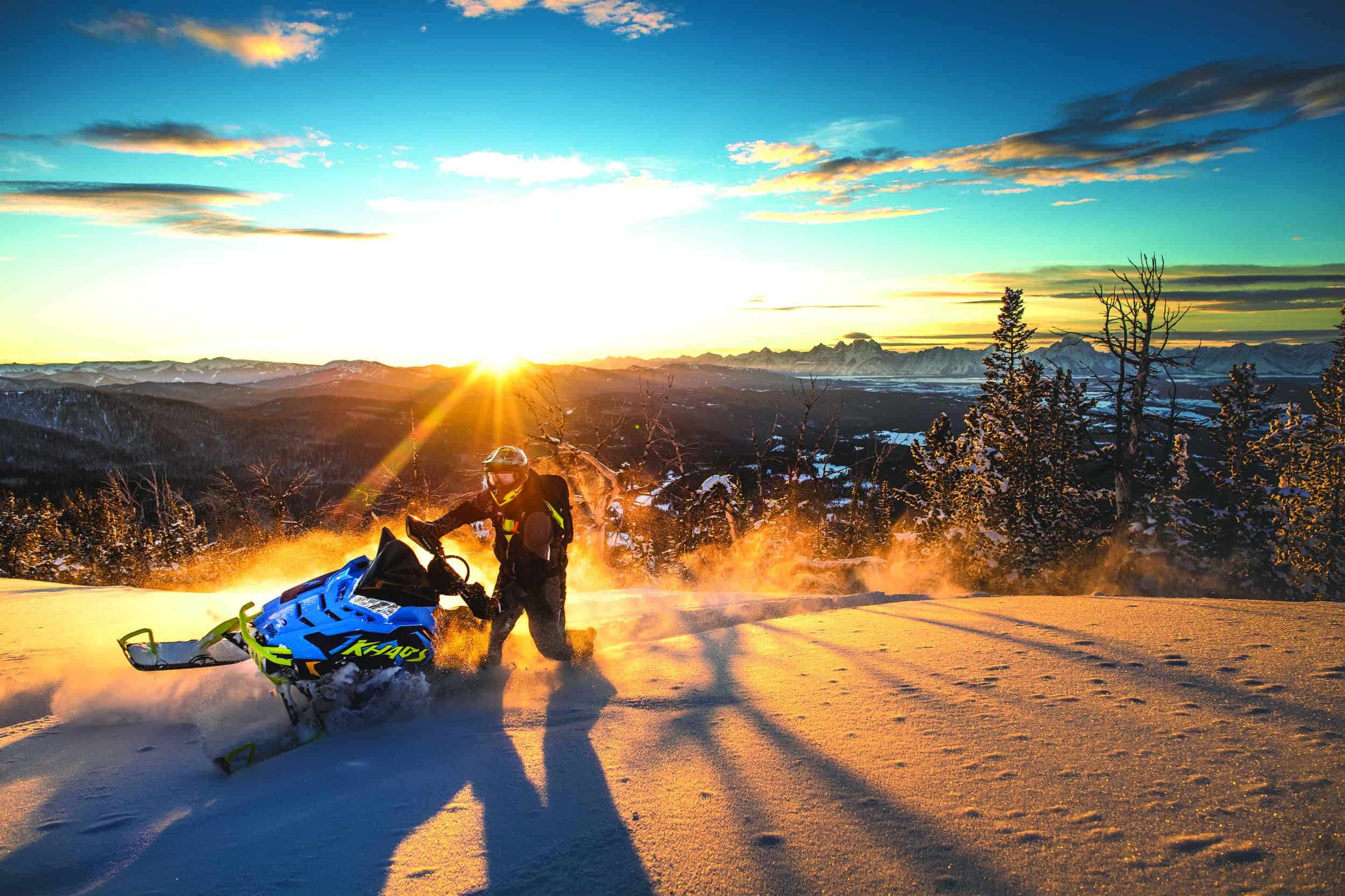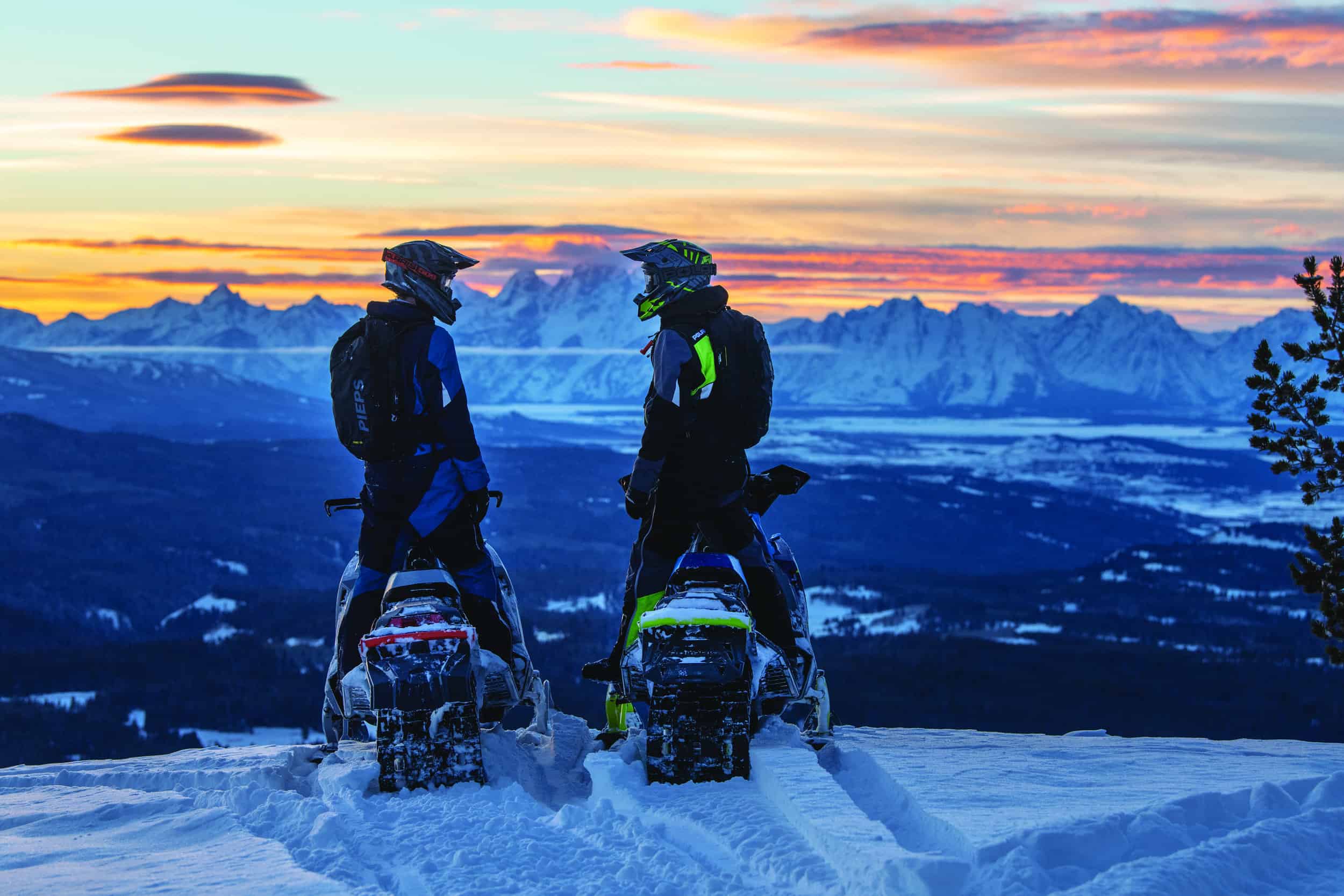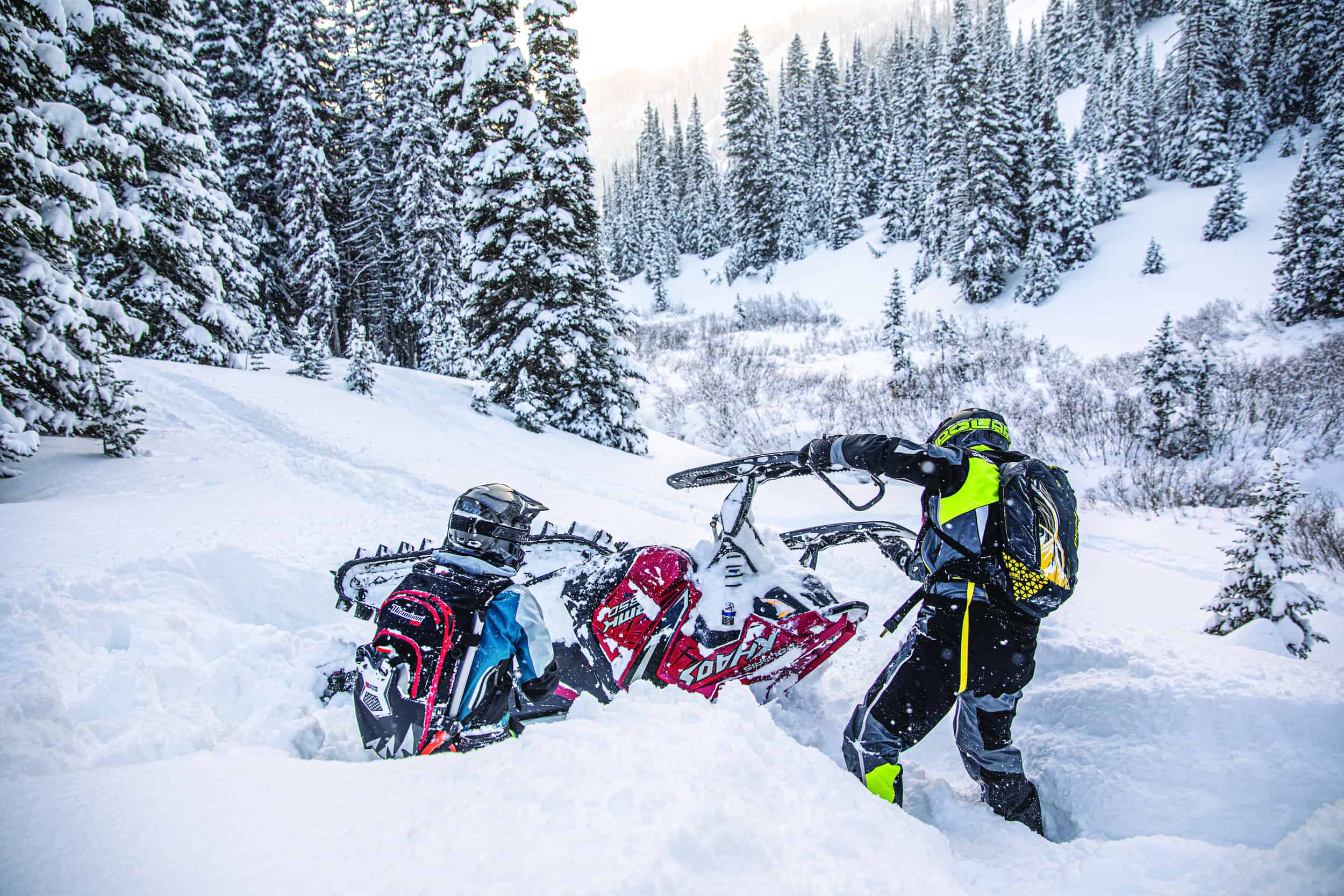Read The
Current Issue
Tremendous, Treacherous Togwotee
The Continental Divide Trail System is a mecca for snowmobilers looking for backcountry and groomed-trail riding. Hazards lurk, too, and sometimes get the best of flatlander sledders.
// By Mike Koshmrl // photography By Todd williams

Dreamy powder days tearing along the frozen slopes up on Togwotee Pass have been easy to come by in Skinner Bell’s lifetime. Bell was born to and raised by a Togwotee snowmobile guide, Jerry Bell. And Skinner, too, went on to build a career guiding on the roughly 600 miles of trails that span out in all directions from the federal highway—U.S. Highway 26/287—that tops out at 9,659 feet, straddling the Continental Divide as it traverses the pass. Bell paints a picture of when the stars align and the sledding is to die for in the high peaks northeast of Jackson: “It’s like right around zero degrees, with three or four feet of blower pow,” he says. “I don’t care if it’s out in the middle of a meadow, in the hills, or wherever, as long as I’m just having fun with my friends or whoever I’m riding with. I wish it was like that every day.”
This prospect of powder perfection just off the highway has made Togwotee Pass into a bucket-list destination for snowmobilers. In fact, it’s not hyperbole to say that it’s the top backcountry snowmobiling area in the United States. For years SnoWest Magazine (a snowmobiling publication) surveyed its readers, inquiring where they like to ride, and many of those years Togwotee Pass and the broader Continental Divide Snowmobile Trail System was at the top of the list. Bell gets it. “The sky’s the limit,” he says about this area, which is known as the granddaddy of systems in the West. “It’s just so big. There’s nothing else like it. You can see the Tetons off the Continental Divide Trail. You can go over toward Dubois and Union Pass and see the red rocks. You can go all the way down to the Gros Ventre to the elk feedground.”
There’s an inverse to those perfect days of Togwotee snowmobiling, and that’s when peoples’ lives are on the line. Bell has witnessed it firsthand and has partaken in plenty of rescues. “I’ve had guests get buried [in avalanches] and dug them out, thank God,” he says. Togwotee snowmobilers, especially unguided ones, end up injured or worse with some regularity. Crunching the data from 2009 to the present, Teton County Search and Rescue coordinator Mike Estes found there were 45 SAR responses involving snowmobiles on Togwotee Pass—an average of more than three incidents per year. It’s a mixed bag of avalanche burials, collisions with trees, riders getting lost or stuck, and the assortment of injuries those accidents cause. “That doesn’t include people getting hurt and riding out on their own, or when the guides are responding to it,” Estes says.
“The sky’s the limit. It’s just so big. There’s nothing else like it.”
—Snowmobile guide Skinner Bell on the riding around Togwotee
Tragedies are the less talked-about part of the Togwotee snowmobiling scene. Almost annually, a snowmobiler will die on Togwotee. In 2014 an avalanche buried and killed a 26-year-old Iowa man. Two years after that, a 33-year-old North Dakotan met his end from blunt force trauma after hitting a tree. A Ten Sleep, Wyoming, man died in 2017, the result of obstructed visibility causing him to land on the highway and break his neck. In 2018 another young Iowa man died in an avalanche—the exact same fate that claimed a two twentysomething Wisconsinites in two separate incidents the very next winter in 2019. Another young Midwestern man died snowmobiling Togwotee in 2021, this time a 24-year-old Minnesotan.
Alpine resident Justin Fritz, who’s on the board of directors at the Wyoming State Snowmobile Association, says that there’s a caricature of the snowmobilers who tend to flock to Togwotee Pass. “It’s a lot of Midwesterners, especially Wisconsin, Minnesota, Michigan,” he says. “They don’t necessarily have the avalanche training that they should have to come to a place like this, especially coming from flatland states. If you’re going to a place like Togwotee, in my opinion you should have to have a guide. A lot of these folks are coming from places where you can just pick up a map and ride.” Advancements in snowmobile technology have exacerbated the troubling trends. Today’s backcountry sleds are lighter, higher powered, and have longer tracks with powder-proficient paddles, which together enable riders to reach riskier terrain, whether they know it or not. “You can’t just pick up a map and ride in a place like Togwotee,” Fritz says. “There are concerns, and they are called avalanches.”
“You can’t just pick up a map and ride in a place like Togwotee. There are concerns, and they are called avalanches.”
—Justin Fritz, Wyoming State Snowmobile Association
Fortunately, there are indications that the flatlanders who have historically been getting into trouble on Togwotee Pass are changing their behavior. “There are more and more people from the Midwest getting more and more training,” says Cameron Chimenti, who grew up in Dubois and now runs Laramie-based 3C Guiding. “It’s because their wife heard that somebody passed away in an avalanche here, and they don’t want it to be their husband next.”
Organizations that offer training are also ramping up. In 2016 the Mountain Riding Lab launched in Jackson, offering avalanche-hazard management courses tailored specifically to snowmobilers and snow bikers. Some of their classes take place in the field on Togwotee Pass. Estes, at Teton County Search and Rescue, emphasized the importance of avalanche education, which can teach riders which types of terrain to avoid and what to do when the snow unexpectedly slides and buries a pal. “We should be going to those snowmobiling clubs in the Midwest and telling them, ‘Hey, you’re coming out, take an avalanche course,’” Estes says. “I think that’s the biggest thing. Sometimes even the best riders get caught. It’s something that just happens.”
It’s a core part of Bell’s job to avert accidents, and he even finds himself dishing out guidance over social media and to unguided riders he encounters up in the hills. “I know the snowpack really well, and I know the areas where not to go,” he says. “As a guide, I always think where I want to go while still making the client happy. At the end of the day, the goal is to bring everybody back alive.”
Many of those perfect powder days end with guys—there are female snowmobilers, but the sport is most popular with men—sitting around the bar at places like Togwotee Mountain Lodge and giving each other good ribbings. Bell builds games into his standard guiding outings: whoever gets stuck in the snow the most has to wear a special, shameful hat and buy the first round at the bar. That’s a playful tactic that’s partly in jest, he says. But it’s also geared toward motivating his clients to make smart choices in the sometimes-deadly Togwotee backcountry. “Everybody starts thinking more about their decisions before they go and do it,” Bell says. JH

Where to Stay, Ride, and Rent
There are several commercial lodges in the Togwotee Pass area that cater their wintertime operations to snowmobilers. The largest and most well-known is Togwotee Mountain Lodge (togwoteelodge.com), which offers 54 cabins and several dozen rooms on land permitted by Bridger-Teton National Forest. Immediately accessible are hundreds of miles of groomed trails in the forest and hundreds of thousands of acres of ridable slopes and meadows. A snowmobile rental shop, bar, restaurant, and gas station are on the premises, too, so wintertime guests don’t have to go anywhere—except to go ride. Four miles off the highway down a groomed snowmobile trail is Turpin Meadow Ranch (turpinmeadowranch.com), which has its own network of trails maintained for cross-country skiers and fat bikers, and which connects to the Continental Divide Snowmobile Trail System. For visitors looking for a more upscale wintertime experience, try Brooks Lake Lodge and Spa (brookslake.com/winter), an all-inclusive resort that’s five miles off the highway and only accessible by snowmobile or tracked vehicle. On the Dubois side of Togwotee Pass is Lava Mountain Lodge (lavamountainlodge.com), a rustic drive-up lodge and restaurant that overlooks the Wind River.

Staying Safe in the Backcountry
Hiring a guide isn’t just something novice snowmobilers should consider; it’s advised that even experts unfamiliar with the Togwotee Pass terrain consider going along with someone who knows the area. “You can get into some pretty extreme, treacherous terrain pretty quickly,” Cameron Chimenti, 3C Guiding’s (3cguiding.com) owner, says. “That’s why we have jobs as guides—people hire us to keep them out of that stuff.” Other businesses that offer guided riding on the Continental Divide Snowmobile Trail System include Togwotee Mountain Lodge, Brooks Lake Lodge, Lava Mountain Lodge, Old Faithful Snowmobile Tours (snowmobilingtours.com), and Scenic Safaris (scenic-safaris.com), among others. It’s highly recommended that do-it-yourself riders who are not acquainted with avalanche terrain take a course so they know what they’re getting into. Besides Mountain Riding Lab (themountainridinglab.com), which specializes in classes for snowmobilers, the American Avalanche Institute (americanavalancheinstitute.com) also offers classes for recreational winter travel and avalanche rescue in the Jackson Hole area. Find updates on avalanche conditions via the Bridger-Teton Avalanche Center, which provides daily forecasts specific to Togwotee Pass (jhavalanche.org).





